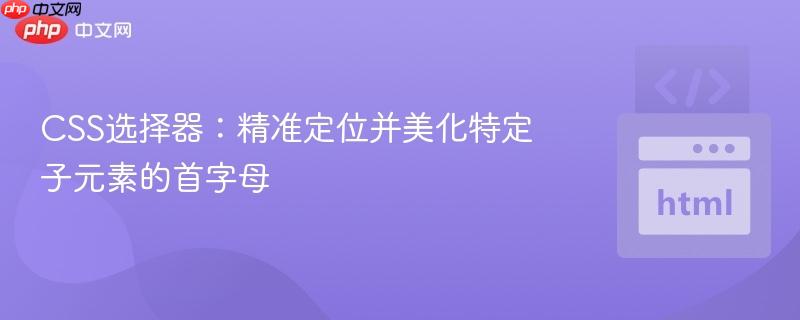
本文详细介绍了如何利用css选择器精准定位父元素内特定类型的第一个子元素,并对其首字母进行样式化。通过结合使用:first-of-type和:first-letter伪类,开发者可以避免意外地对所有同类型元素应用样式,从而实现更精细的页面布局和视觉效果。文章提供了示例代码,帮助读者理解并掌握这一实用的css技巧。
在网页设计中,我们经常需要对页面中的特定元素应用独特的样式,以提升视觉吸引力和用户体验。一个常见的需求是,在一个父容器内,只对特定类型的第一个子元素的第一个字母进行特殊处理,例如制作“首字下沉”效果(drop cap)。然而,如果不理解CSS选择器的细微差别,可能会遇到意想不到的结果。
假设我们有一个div容器,其ID为content,内部包含一个h2标题和两个p段落。我们的目标是只改变第一个<p>标签的首字母样式。
HTML结构如下:
<div id="content"> <h2 role="heading">This demonstrates absolute positioning</h2> <p>Static positioning is the default and relative is much like static but the difference is the box with relative can be offset from its original position with the properties top, right, bottom, left.</p> <p>As we can see with this demonstration of absolute positioning, the navigation to the left is placed out of the normal flow of the page and delivers it to a world all on its own. It can be placed anywhere on the page we want it to be.</p> </div>
初学者可能会尝试使用如下CSS来选中第一个<p>标签的首字母:
立即学习“前端免费学习笔记(深入)”;
#content > p:first-letter {
font-size: 32px;
}然而,这种做法会导致所有直接子元素<p>的首字母都被应用相同的样式。这是因为:first-letter伪元素会应用于其所在元素的第一个字母,而#content > p选择器匹配了所有作为#content直接子元素的<p>标签。因此,上述CSS会同时影响两个<p>标签的首字母,这与我们的预期不符。
要实现只对特定类型(例如<p>)的第一个子元素的第一个字母进行样式化,我们需要引入:first-of-type伪类。
:first-of-type伪类选择器匹配其父元素中相同类型元素的第一个兄弟元素。这意味着,如果父元素中有多个<p>标签,:first-of-type只会选中第一个出现的<p>标签。
这与:first-child伪类有所不同。:first-child选择器匹配其父元素中的第一个子元素,无论其类型是什么。例如,如果<h2>是#content的第一个子元素,那么#content > p:first-child将不会匹配任何元素,因为第一个子元素不是<p>。而#content > p:first-of-type则会正确匹配第一个<p>标签。
通过将:first-of-type与:first-letter结合使用,我们可以精确地定位到目标元素的首字母。
修正后的CSS代码如下:
#content > p:first-of-type:first-letter {
font-size: 32px;
}这段CSS的含义是:
使用这个修正后的CSS,只有#content下的第一个<p>标签的首字母会被设置为32px的字体大小,而第二个<p>标签则保持不变,完美符合我们的需求。
<!DOCTYPE html>
<html lang="zh-CN">
<head>
<meta charset="UTF-8">
<meta name="viewport" content="width=device-width, initial-scale=1.0">
<title>CSS选择器:精准定位并美化特定子元素的首字母</title>
<style>
body {
font-family: Arial, sans-serif;
line-height: 1.6;
color: #333;
margin: 20px;
}
#content {
border: 1px solid #ddd;
padding: 15px;
background-color: #f9f9f9;
margin-bottom: 30px;
}
#another-content {
border: 1px solid #ddd;
padding: 15px;
background-color: #f9f9f9;
}
h2 {
color: #0056b3;
}
/* 修正后的CSS:只影响 #content 内第一个 p 标签的首字母 */
#content > p:first-of-type:first-letter {
font-size: 32px;
font-weight: bold;
color: #d9534f;
float: left; /* 常见的首字下沉效果 */
margin-right: 5px;
line-height: 1;
}
/* 另一个示例:展示即使 p 不是第一个子元素,但它是第一个 p 类型元素 */
#another-content > p:first-of-type:first-letter {
font-size: 32px;
color: green;
font-weight: bold;
float: left;
margin-right: 5px;
line-height: 1;
}
</style>
</head>
<body>
<div id="content">
<h2 role="heading">This demonstrates absolute positioning</h2>
<p>Static positioning is the default and relative is much like static but the difference is the box with relative can be offset from its original position with the properties top, right, bottom, left.</p>
<p>As we can see with this demonstration of absolute positioning, the navigation to the left is placed out of the normal flow of the page and delivers it to a world all on its own. It can be placed anywhere on the page we want it to be.</p>
</div>
<h3>进一步思考:如果h2不是第一个子元素,p是呢?</h3>
<div id="another-content">
<p>This is the first paragraph in 'another-content'. Its first letter should be styled.</p>
<h2>Another heading here</h2>
<p>This is the second paragraph in 'another-content'. Its first letter should NOT be styled.</p>
</div>
</body>
</html>通过掌握:first-of-type和:first-letter伪类的组合使用,开发者可以更灵活、更精确地控制网页元素的样式,实现各种复杂的视觉效果,从而提升用户界面的美观度和专业性。在处理特定类型子元素的样式需求时,请务必考虑使用:first-of-type来避免不必要的副作用。
以上就是CSS选择器:精准定位并美化特定子元素的首字母的详细内容,更多请关注php中文网其它相关文章!

每个人都需要一台速度更快、更稳定的 PC。随着时间的推移,垃圾文件、旧注册表数据和不必要的后台进程会占用资源并降低性能。幸运的是,许多工具可以让 Windows 保持平稳运行。

Copyright 2014-2025 https://www.php.cn/ All Rights Reserved | php.cn | 湘ICP备2023035733号